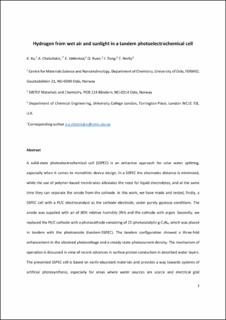| dc.contributor.author | Xu, Kaiqi | |
| dc.contributor.author | Chatzitakis, Athanasios Eleftherios | |
| dc.contributor.author | Vøllestad, Einar | |
| dc.contributor.author | Ruan, Qiushi | |
| dc.contributor.author | Tang, Junwang | |
| dc.contributor.author | Norby, Truls Eivind | |
| dc.date.accessioned | 2020-12-28T12:07:21Z | |
| dc.date.available | 2020-12-28T12:07:21Z | |
| dc.date.created | 2018-12-23T21:03:48Z | |
| dc.date.issued | 2019 | |
| dc.identifier.citation | International journal of hydrogen energy. 2019, 44 (2), 587-593. | en_US |
| dc.identifier.issn | 0360-3199 | |
| dc.identifier.uri | https://hdl.handle.net/11250/2721011 | |
| dc.description.abstract | A solid-state photoelectrochemical (SSPEC) cell is an attractive approach for solar water splitting, especially when it comes to monolithic device design. In a SSPEC cell the electrodes distance is minimized, while the use of polymer-based membranes alleviates the need for liquid electrolytes, and at the same time they can separate the anode from the cathode. In this work, we have made and tested, firstly, a SSPEC cell with a Pt/C electrocatalyst as the cathode electrode, under purely gaseous conditions. The anode was supplied with air of 80% relative humidity (RH) and the cathode with argon. Secondly, we replaced the Pt/C cathode with a photocathode consisting of 2D photocatalytic g-C3N4, which was placed in tandem with the photoanode (tandem-SSPEC). The tandem configuration showed a three-fold enhancement in the obtained photovoltage and a steady-state photocurrent density. The mechanism of operation is discussed in view of recent advances in surface proton conduction in absorbed water layers. The presented SSPEC cell is based on earth-abundant materials and provides a way towards systems of artificial photosynthesis, especially for areas where water sources are scarce and electrical grid infrastructure is limited or nonexistent. The only requirements to make hydrogen are humidity and sunlight. | en_US |
| dc.language.iso | eng | en_US |
| dc.publisher | Elsevier | en_US |
| dc.rights | Attribution-NonCommercial-NoDerivatives 4.0 Internasjonal | * |
| dc.rights.uri | http://creativecommons.org/licenses/by-nc-nd/4.0/deed.no | * |
| dc.subject | earth‐abundant materials | en_US |
| dc.subject | polymer electrolytes | en_US |
| dc.subject | water vapor electrolysis | en_US |
| dc.subject | surface proton conduction | en_US |
| dc.subject | tandem photoelectrocatalysis | en_US |
| dc.subject | solid‐state photoelectrochemical cells | en_US |
| dc.title | Hydrogen from wet air and sunlight in a tandem photoelectrochemical cell | en_US |
| dc.type | Peer reviewed | en_US |
| dc.type | Journal article | en_US |
| dc.description.version | acceptedVersion | en_US |
| dc.rights.holder | This is the authors’ accepted and refereed manuscript to the article.This manuscript version is made available under the CC-BY-NC-ND 4.0 license | en_US |
| dc.source.pagenumber | 587-593 | en_US |
| dc.source.volume | 44 | en_US |
| dc.source.journal | International journal of hydrogen energy | en_US |
| dc.source.issue | 2 | en_US |
| dc.identifier.doi | 10.1016/j.ijhydene.2018.11.030 | |
| dc.identifier.cristin | 1647073 | |
| dc.relation.project | Norges forskningsråd: 250261 | en_US |
| dc.relation.project | Norges forskningsråd: 239211 | en_US |
| cristin.unitcode | 7401,80,62,0 | |
| cristin.unitname | Bærekraftig energiteknologi | |
| cristin.ispublished | true | |
| cristin.fulltext | postprint | |
| cristin.qualitycode | 2 | |

